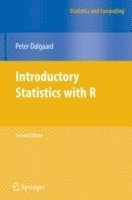
- Format
- Häftad (Paperback / softback)
- Språk
- Engelska
- Antal sidor
- 364
- Utgivningsdatum
- 2008-08-15
- Upplaga
- 2nd ed. 2008
- Förlag
- Springer-Verlag New York Inc.
- Illustrationer
- XVI, 364 p.
- Dimensioner
- 235 x 155 x 17 mm
- Vikt
- Antal komponenter
- 1
- Komponenter
- 1 Paperback / softback
- ISBN
- 9780387790534
- 540 g
Introductory Statistics with R
- Skickas från oss inom 5-8 vardagar.
- Fri frakt över 249 kr för privatkunder i Sverige.
Passar bra ihop
De som köpt den här boken har ofta också köpt Co-Intelligence av Ethan Mollick (häftad).
Köp båda 2 för 996 krKundrecensioner
Recensioner i media
From the reviews: TECHNOMETRICS "extensive, well organized, and well documentedThe book is an elegant R companion, suitable for the statistically initiated who want to program their own analyses. For experienced statisticians and data analysts, the book provides a good overview of the basic statistical analysis capabilities of R and presumably prepares readers for later migration to SThe format of this compact book is attractiveThe book makes excellent use of fonts and intersperses graphics near the codes that produced them. Output from each procedure is dissected line by line to link R code with the computed resultI can recommend [this book] to its target audience. The author provides an excellent overview of R. I found the wealth of clear examples educational and a practical way to preview both R and S." "The scope of the book, introductory statistics, is a very useful set of methods in parametric and non-parametric statistics up to logistic regression and survival analysis. Where many constructs in R are very attractive for mathematical oriented users, e.g. matrices, Dalgaard succeeded in convincing me that with little extra effort they can be made very useful to less mathematically oriented people, e.g. by specifying row and column names, and proposing quite attractive ways to specify for example subsets of rows and columns." (Dr. H. W. M. Hendriks, Kwantitatieve Methoden, Vol. 72B8, 2003) "R is an Open Source implementation of the well-known S language. It works on multiple computing platforms and can be freely downloaded. R is thus ideally suited for teaching at many levels as well as for practical data analysis and methodological development. This book provides an elementary-level introduction to R, targeting both non-statistician scientists in various fields and students of statistics. Brief sections introduce the statistical methods before they are used. A supplementary R package can be downloaded and contains thedata sets." (Zentralblatt fr Didaktik der Mathematik, August, 2004) "This is a nice book on statistical methods and statistical computing in R, a language and environment for statistical computing and graphs: this dialect of the S language is available as free software through internet. Explanation of statistical methods, together with an interpretation of statistical concepts, is the prevailing style of the text. They are illustrated by plenty of practical examples, all computed using R. This book will be useful for novices in applied statistics or in computing in R." (European Mathematical Society Newsletter, September, 2003) "The book is an elegant R companion, suitable for the statistically initiated who want to program their own analyses. For experienced statisticians and data analysts, the book provides a good overview of the basic statistical analysis capabilities of R prepares readers for later migration to S. I can recommend Introductory Statistics With R toits target audience. The author provides an excellent overview of R. I found the wealth of clear examples educational and a practical way to preview both R and S." (Thomas D. Sandry, Technometrics, Vol. 45 (3), 2003) "R is both a statistical computer environment and a programming language designed to perform statistical analysis and to produce adequate corresponding graphics. The present book is a very useful guide for introducing a number of basic concepts and techniques necessary to practical statistics, covering both elementary statistics and actual programming in the R language. The book is organized in 12 chapters and three appendices, each chapter ending with a beneficial section of proposed exercises." (Silvia Curteanu, Zentralblatt MATH, Vol. 1006, 2003) From the reviews of the second edition: This review roughly cover the introductory topics of a first year statistics course. The Introductory Statistics with R (I
Övrig information
Peter Dalgaard is associate professor at the Biostatistical Department at the University of Copenhagen and has extensive experience in teaching within the PhD curriculum at the Faculty of Health Sciences. He was chairman of the Danish Society for Theoretical Statistics from 1996 to 2000. Peter Dalgaard has been a key member of the R Core Team since August 1997 and is well known among R users.
Innehållsförteckning
Basics.- The R environment.- Probability and distributions.- Descriptive statistics and graphics.- One- and two-sample tests.- Regression and correlation.- Analysis of variance and the KruskalWallis test.- Tabular data.- Power and the computation of sample size.- Advanced data handling.- Multiple regression.- Linear models.- Logistic regression.- Survival analysis.- Rates and Poisson regression.- Nonlinear curve fitting.


